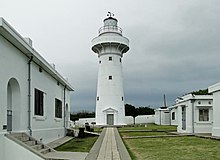Eluanbi Lighthouse
 | |
 | |
| Location | Eluanbi Village Hengchun Pingtung County Taiwan |
|---|---|
| Coordinates | 21°54′08″N 120°51′09″E / 21.902282°N 120.852622°E |
| Tower | |
| Constructed | 1883[1] |
| Foundation | concrete and granite |
| Construction | cast iron tower[2] |
| Height | 21.4 m (70 ft)[1] |
| Shape | cylindrical tower with balcony and lantern on one-story keeper's house and visitor building[2] |
| Markings | white tower, black lantern dome[2] |
| Operator | Maritime and Port Bureau[1] |
| Light | |
| Focal height | 56.4 m (185 ft)[1] |
| Lens | Fourth order fresnel |
| Intensity | 1,800,000 candela |
| Range | 27.2 nmi (50.4 km; 31.3 mi)[1] |
| Characteristic | Fl W 10s.[2] |
| Eluanbi Lighthouse | |
|---|---|
| Chinese name | |
Hanyu Pinyin | Éluánbí Dēngtǎ |
| Wade–Giles | O-luan-pi Têng-t’a |
| Southern Min | |
| Hokkien POJ | Gô-lôan-phīⁿ Teng-thah |
| Transcriptions | |
|---|---|
| Romanization | Garanbi Tōdai |
Eluanbi Lighthouse is a
Names
The lighthouse is named after nearby
pronunciation.Eluanbi Lighthouse is also known as "The Light of East Asia" because its light is the most intense of those on Taiwan.[1]
History
Qing Empire
Construction of the Eluanbi Lighthouse fell under the purview of the
Construction began in 1881.
The first tower was 15 m (50 ft) high and
The garrison was later reduced to eight men.[8]
Imperial Japan
During the
During
Republic of China
The lighthouse was rebuilt by the Republic of China in 1947.[7] It was refurbished with a powerful Fresnel lens in 1962.[1] The surrounding Eluanbi Park opened to the public on 25 December 1982[11] and the lighthouse itself welcomed regular visitors ten years later.[1]
On the memorial to Eluanbi Lighthouse as one of the
Transportation
The lighthouse is accessible from Provincial Highway 26.
Gallery
-
Eluanbi c. 1934
-
Eluanbi on a 1939Japanese stamp
-
Side view (2010)
-
Sunrise on Cape Eluanbi (2016)
-
The view from Eluanbi (2017)
-
Sunset at Eluanbi (2017)
See also
References
Citations
- ^ a b c d e f g h i j MPB (2019).
- ^ a b c d e f Rowlett (2007).
- ^ a b Eskildsen (2019), p. 38.
- ^ a b c d Wang & al. (2016).
- ^ a b c Alsford (2018), pp. 67–8
- ^ Harding, John Reginald (1901). "A brief description of the erection of a first order light-house on the South Cape of Formosa". Transactions of the Shanghai Society of Engineers and Architects. Reed Digital Collections: 49–74. Retrieved 5 April 2022.
- ^ a b c d e 鹅銮鼻灯塔, WSHNT, KUAS. (in Chinese)
- ^ a b c d e f g h i j Dudbridge (1999), pp. 12–13.
- ^ Dudbridge (1999), p. 3.
- ^ a b c d Keller.
- ^ KNP (2019).
Bibliography
- 鵝鑾鼻公園, Official site, Kending: Kenting National Park Headquarters, 2019, archived from the original on 2008-12-10, retrieved 2021-05-21. (in Chinese)
- "Eluan Pi Lighthouse", Official website, Taipei: Maritime and Port Bureau, 2019, archived from the original on 2019-04-11, retrieved 2019-03-16.
- ISBN 9781315279190.
- Dudbridge, Glen, ed. (1999), "George Taylor and the Peoples of the South Cape", Aborigines of South Taiwan in the 1880s, Monograph No. 2, Taipei: Shung Ye Museum of Formosan Aborigines.
- Eskildsen, Robert (2019), Transforming Empire in Japan and East Asia: The Taiwan Expedition and the Birth of Japanese Imperialism, Singapore: Palgrave Macmillan, ISBN 9789811334801.
- Harding, John Reginald (1901). "A brief description of the erection of a first order light-house on the South Cape of Formosa". Transactions of the Shanghai Society of Engineers and Architects. Reed Digital Collection: 49–74.
- Keller, Ian, "George Taylor", 19th-Century European & North American Encounters with Taiwan: A Bibliography of Texts Input, Portland: Reed College.
- Rowlett, Russ (2007). "Lighthouses of Taiwan: Southeastern". The Lighthouse Directory. University of North Carolina at Chapel Hill.
- Wang Shuhui; et al. (May 2016), 清末恆春地區涉外事件與鵝鑾鼻燈塔興建之關係(1867-1883), 《美和學報》, vol. 35, Neipu: Meiho University, pp. 29–46. (in Chinese)
External links
- Eluanbi Lighthouse-Directorate General of Customs(Taiwan) Archived 2012-08-03 at the Wayback Machine (in English and Chinese)







